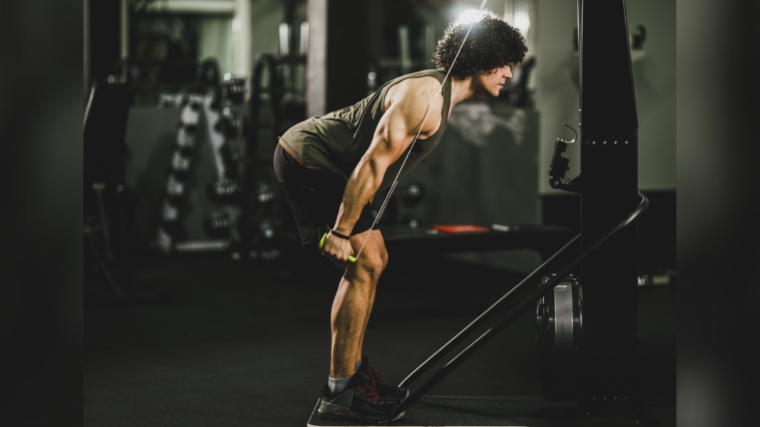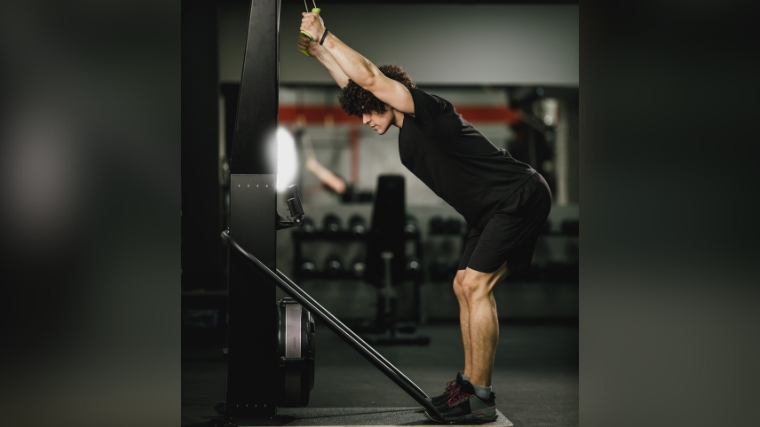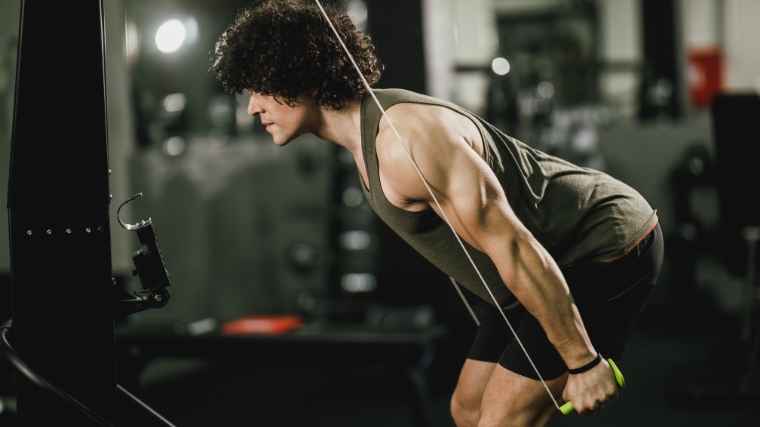In the wide world of CrossFit, full-body conditioning is the name of the game. Sometimes, that involves extensive endeavors on cardio machines. Throughout WODs (workouts of the day), you’ll do everything from rowing machine sprints to marathons on the rower.
While rowing machines are commonplace in commercial gyms and CrossFit boxes alike, the ski erg is a rarer addition. But these vertically-oriented machines, which simulate skiing instead of rowing, are incredibly useful allies in your quest to become both stronger and fitter.

Here, you’ll learn the best ski erg workout for CrossFitters — and how to modify it for your experience level.
What Is the Ski Erg?
The ski erg is a stationary exercise machine meant to simulate cross-country skiing. The handles of the machine are situated above the athlete’s head, with the flywheel situated toward the bottom of the machine. This circular component allows air to flow through while resistance is being generated.
Athletes will find a damper on the side of the flywheel. This small lever will adjust the amount of air that can flow into the flywheel. The damper does not, as many athletes might assume, increase or decrease the resistance.
As with a rowing machine, you provide the level of resistance based on the speed at which you pull. The harder you pull, the stronger the resistance provided by the machine.
For beginners, start with a damper setting at three or below. Lower settings allow less air into the flywheel, making it easier to make the wheel spin. Otherwise, you run the risk of exhausting your muscles — and your lungs — before you get the chance to complete your workout. Only increase the damper setting incrementally.
How to Use the Ski Erg
This machine may seem exotic and complicated. You certainly won’t find it in every commercial gym, as you do with treadmills and ellipticals. But the form is actually relatively simple to master. Just imagine you’re skiing down a snowy slope. More specifically, here’s how to use the ski erg with good form.
- Stand facing the machine with your feet shoulder-width apart. Grasp the handles so that your hands are slightly above your head, also at shoulder width. Keep a slight bend in your knees and your elbows.
- Engage your core and bend your knees. Keeping your back neutral, hinge forward slightly. On an exhale, drive the handles down, keeping your hands relatively close to your face.
- Keeping your knees bent and your back neutral, continue to lean forward to support your arms driving all the way down and back behind your thighs.
- Reverse the movement, bringing your arms back up above your head. Reset your body’s position before repeating. Perform this transition as smoothly as possible.
Because you’re providing the resistance, the only thing you have to do to start using the machine is pull down on the handles.
How to Read a Ski Erg Display
While different machines will have slightly different setups, the Concept2 SkiErg is what you’ll likely find in your gym or CrossFit box. Just start pulling to activate the display. The biggest number you see will likely be an indication of how many minutes and seconds it will take for you to ski 500 meters.

[Read More: The Best Ab Exercises & Workouts, According to a CPT]
Over time, your aim will be to decrease this number, which will mean you’re able to move a greater distance over a shorter period of time. But don’t fire on all cylinders to get this number as low as possible right away — instead, aim to have a consistent 500-meter pace. That consistent number will generally improve (decrease) with practice.
The number just above your 500-meter pace will generally be your elapsed time — AKA, how long you’ve been doing this particular workout. The number below your 500-meter pace will be your total meters “traveled” this session. On the bottom left, you’ll find your stroke rate, or cadence. This will tell you how many strokes per minute you’re performing.
Again, don’t use up all your energy trying to get your cadence as high as possible. More strokes per minute aren’t necessarily better. Consider your goals and balance them with your form.
If you’re looking to improve your overall cardiovascular health, a lower stroke rate will be more sustainable over the course of 15-30 minute workouts. On the other hand, if you want to give yourself more explosive power over a short period of time, going all out for a short burst may be more suitable. You’ll get better gains with excellent form, so always stay on top of that.
Benefits of the Ski Erg
Using the ski erg can help with a wide variety of goals. In CrossFit, you’ll use this machine in your WODs. But the benefits go far beyond that. Whether you work your WODs daily or have designed your own training program, here are some of the ways the ski erg can work for you.
Low-Impact Cardio
You can do an extremely high-intensity workout with the ski erg — but your feet will stay in the same place the whole time. Because of this, your feet, ankles, and knees will all be under a lot less repetitive stress than they would if you were running.
As a CrossFitter, optimizing your performance is key to making gains. The ski erg can help you add higher-intensity sprints to your routine without putting a lot of stress on your joints. Your joints will thank you for sprinkling challenging but low-impact moves into those high-impact box jumps.
Higher Work Capacity
The more emphasis your program puts on both sprinting and lower-intensity endurance moves — the ski erg provides both — the better your work capacity is likely to be. Work capacity refers to your ability to perform a certain amount of work in a given period of time. An excellent work capacity is a CrossFitter’s bread and butter.
You can use the ski erg to target whatever weakness you have in your conditioning game. Maybe you’re already good at events or WODs that require you to push through one move for a long period of time. The ski erg can help you target shorter, high-intensity sprints to boost your capacity to endure those types of workouts.

On the flip side, you can use the ski erg as a low-impact way to add longer, more steady-state endurance training to your routine. This can improve your body’s ability to handle a higher volume of work. Because it has such a low impact on your joints, you’ll be able to perform higher volumes with less risk of a form breakdown.
Versatile
If you’re heading into your box for an extra training session or are looking to design your own WOD, the ski erg will come in handy. You can use it for short sprint intervals, but it’s just as useful for longer, low-intensity sessions that you can swap in place of a jog on the treadmill. Whatever your specific conditioning goals are, the ski erg is a versatile enough tool to help.
Because it’s so low-impact, the ski erg is also an excellent tool to work into active recovery. You can do this by programming 15 to 45-minute, low-intensity ski erg sessions on active recovery days. Alternatively, you can weave ski erg sprints or 500-meter pulls into your barbell training.
Space Saving
Not a lot of space in your home gym? Not a problem. Most cardio equipment — think treadmills and rowers — require several feet of floor space to accommodate everything you need to run or row. With a ski erg, most of the real estate is vertical.
So, if you’ve only got a corner of your office available to add a piece of cardio equipment to, the ski erg might be your most economical bet in terms of space.
Get Stronger
Yes, you’ll be pulling with your upper body, but your entire body will pitch in. Your lats, traps, and biceps will pitch in big time during the pull. Your triceps and rear delts will work overtime during the finish. The entire time, your core will be putting in a tremendous amount of effort into keeping your torso stable and strong.
[Read More: Best Lower Back Exercises for Strength and Reduced Pain]
You’ll also be hinging at the hips during each pull. Even though they won’t be doing the majority of the work, you’d better believe your hamstrings, quads, glutes, and even your lower back will feel it in the morning.
Best CrossFit Ski Erg Workout
Sometimes, the best — and hardest — workouts are the simplest. It’s fitting that a deceptively simple machine like the ski erg would involve deceptively simple workouts. The following protocol may seem incredibly underwhelming, but once you try it, you’ll know why it’s the best in its class.
The Workout
Perform this workout at a pace determined by your experience level.
- 30 seconds skiing
- 30 seconds rest
- Repeat between 5 and 20 times
Below, you’ll find ways to modify this simple ski erg workout to suit your experience level.
Only progress when your form is solid, and feel free to use more simple versions of this workout whenever it suits your needs.
Ski Erg Workout for Beginners
As a newbie, you might find that a 1:1 work-to-rest ratio is too intense. In that case, decrease the work time to 15 seconds but keep the 30-second rest. Or, if 30 seconds of work feels fine but you need to rest longer, ski for 30 seconds but rest for a full minute.
Even if you’re an expert in strength sports — you can do muscle-ups in your sleep and clean & jerk like nobody’s business — you might still be a ski erg beginner. If you’ve never used the machine before, start out with the beginner version of the workout.

[Read More: The Best Bodyweight Exercises, + Workouts and Tips From a CPT]
But if your general fitness level allows, you may be able to sustain this workout as written with few problems. Keep the 30 seconds on, 30 seconds off work-to-rest ratio, and perform five to 10 rounds per session.
With a broad base of physical fitness, you might be able to progress rather quickly. Still, start with the basics until you’re sure your form is solid. Once you’re locked in form-wise, go to town on progressions. Start increasing the number of rounds from five to 10 rounds.
Ski Erg Workout for Intermediate Athletes
Once you’ve accumulated some experience with the ski erg, you’ll want to start progressively overloading your workload. To do that, gradually adjust the work-to-rest ratio to increase the amount of work per unit of rest.
Increase the work to 35 or 40 seconds while keeping 30 seconds of rest. Or, keep the 30-second work period while decreasing the amount of rest to 25 or 20 seconds.
Alternatively, you can keep to work-to-rest ratio the same but start to increase the intensity. If you’ve been skiing with a 2:30 minute/500-meter pace, aim to maintain a faster pace — say, 2:25 or 2:20 per 500 meters.
You can also begin to increase the number of rounds you perform. Start inching up toward 15 rounds.
It’s important to only progress one factor at a time. So, if you’re increasing your intensity, don’t also decrease your rest period. Give yourself two to four weeks to adjust to your new progression, then consider adding another.
Ski Erg Workout for Experts
As an expert skier, it’s time to consider working for a longer period of time than you rest. Start adjusting slowly, working for 30 seconds and resting for 25 seconds. Gradually decrease your rest period until you’re working for 30 seconds and resting for 15 seconds. This 2:1 work-to-rest ratio will tremendously improve your work capacity, endurance, and strength.
As an expert, you’ll also be able to significantly improve your pacing. Another method for increasing intensity is working for a shorter period of time but pulling even harder. So instead of pacing yourself for a tough 30 seconds, go all out for 15 seconds. You’ll be able to push yourself much harder.
Just as you did at an intermediate level, only progress one factor at a time.
Remember: just because you’re an expert doesn’t mean you always must perform an expert-level workout. Make sure you’re allowing time and energy for both active recovery and also less intense ski erg training sessions.
No Snow Required
You don’t need snowy slopes to pack in a full skiing workout. You don’t even need to leave your CrossFit box or garage gym. Grabbing the ski erg handles can transform your workout from a strength challenge to a conditioning workout. You can crank up the intensity with sprints or slow it down with a longer, steady-state experience.
Regardless of your goals — or experience level — there are ways to make the ski erg work for you. Whether you find it in your next WOD or during the next CrossFit Games, you’ll be ready to pull your way to a stronger upper body and work capacity.
Featured Image: MilanMarkovic78 / Shutterstock